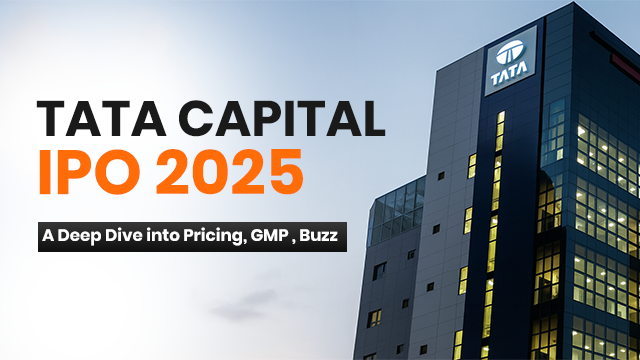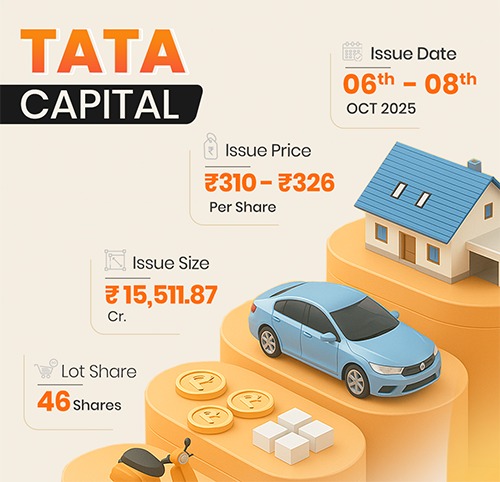Tata Capital IPO is set to become the largest public offering by a Tata Group company in over a decade. With an impressive issue size of approximately ₹15,512 crore, this highly anticipated offering has already generated significant buzz among investors and market watchers alike.
The upcoming IPO has been priced in the range of ₹310 to ₹326 per share, notably at a 56% discount to its last traded unlisted market price of ₹735. Additionally, the offering consists of 47.58 crore shares, including a fresh issue of 21 crore equity shares and an offer for sale of 26.58 crore shares. Scheduled to open from October 6 to October 8, 2025, the Tata Capital IPO GMP (Gray Market Premium) has been fluctuating between ₹25-31 and ₹75-90 per share, indicating potential listing gains for investors.
In this article, we’ll take a comprehensive look at everything you need to know about the Tata Capital IPO. Furthermore, we’ll examine how this offering isn’t just a capitalization event but also driven by regulatory needs, as the RBI has mandated larger NBFCs to list, ensuring more transparency and investor trust. Whether you’re considering investing or simply staying informed, our analysis will help you understand the pricing strategy, market sentiment, and growth prospects of this significant offering from the Tata Group.
Tata Capital IPO 2025: Key Dates and Offer Structure
The much-anticipated Tata Capital IPO has a structured timeline for investors looking to participate. Let me walk through all the essential details you need to know.
IPO opening and closing dates
The subscription window for Tata Capital IPO opens on October 6, 2025, and will remain open until October 8, 2025. This three-day window applies to retail investors, high-net-worth individuals (HNIs), and other eligible categories. Mark your calendars if you’re planning to apply, as this timeframe is fixed without extension possibilities.
Anchor investor timeline
Regarding anchor investors, Tata Capital Ltd has scheduled the bidding day for October 3, 2025. The company has already secured ₹4,641.83 crore from these institutional investors, demonstrating strong pre-listing confidence. For these participants, there’s a structured lock-in period—50% of shares have a 30-day lock-in while the remainder faces a 90-day restriction.
Lot size and minimum investment
For retail investors, the minimum application requires a lot size of 46 shares. Given the upper price band of ₹326, this translates to a minimum investment of ₹14,996 per lot. Small non-institutional investors must apply for at least 14 lots (644 shares), requiring ₹2,09,944, whereas big non-institutional investors need a minimum of 67 lots, amounting to ₹10,04,732.
Breakdown of fresh issue vs OFS
The IPO comprises two components: first, a fresh issue of 21 crore shares aggregating to ₹6,846 crore. Second, an offer for sale (OFS) of 26.58 crore shares worth ₹8,665.87 crore. Within the OFS, Tata Sons will sell 23 crore shares while International Finance Corporation will divest 3.58 crore shares[81]. Importantly, proceeds from the fresh issue will strengthen Tata Capital’s Tier-1 capital base, whereas OFS proceeds go directly to the selling shareholders.
Listing date and exchanges
Following the subscription period, the basis of allotment will be finalized on October 9, 2025[62]. Subsequently, refunds to unsuccessful bidders and crediting of shares to successful applicants’ demat accounts will occur on October 10, 2025. The company has scheduled the listing of shares on both the BSE and NSE for October 13, 2025[81], which is when trading will officially commence.
Understanding Tata Capital IPO GMP
Behind every IPO launch exists an unofficial market that often provides early signals about investor interest. Let’s explore what Tata Capital’s gray market activity reveals about its potential listing performance.
What is Gray Market Premium (GMP)?
Gray Market Premium represents the amount investors are willing to pay above an IPO’s issue price before official listing. Essentially, it’s an unofficial trading environment where IPO applications and shares change hands outside formal exchanges. For example, if Tata Capital’s IPO price is ₹326 and the GMP is ₹25, it suggests investors expect the shares to list around ₹351.
Current GMP trends for Tata Capital
As of September 30, 2025, Tata Capital’s GMP ranges between ₹25-₹31 per share above the upper price band. This indicates a potential listing price of approximately ₹353, suggesting an expected return of about 8.28%. Meanwhile, other tracking platforms report slightly different figures, with some showing a GMP of ₹21 or ₹24, highlighting the volatile nature of these unofficial markets.
How GMP reflects investor sentiment
The premium serves as a barometer of market excitement and demand before listing. A positive GMP, as seen with Tata Capital, generally signals strong investor interest. Nevertheless, this enthusiasm must be viewed in context – the IPO is priced at a steep 56% discount to its last traded unlisted price of ₹735, and 71% below its April 2025 peak of ₹1,125.
Limitations of relying on GMP
Despite its popularity as a predictive tool, GMP carries significant limitations. First, it operates in an unregulated environment with no official oversight. Moreover, historical patterns show that GMP predictions often fail to materialize – nearly 30% of Indian IPOs between 2023-2025 listed below their issue price. The National Securities Depository Ltd IPO presents a cautionary tale where the gray market premium evaporated completely, resulting in a 35% listing-day decline. Consequently, investment decisions based solely on GMP could lead to disappointing outcomes.
Tata Capital’s Financials and Valuation Metrics
Examining the financial health of any IPO prospect remains crucial for informed investment decisions. Let’s analyze what the numbers reveal about Tata Capital’s offering.
Revenue and profit growth over 3 years
Looking at the financial trajectory, Tata Capital has shown consistent growth in its balance sheet size and income generation capacity. The NBFC has focused on expanding its retail and SME lending portfolios, which has contributed to its revenue stability even during market fluctuations.
Key financial ratios post-IPO
After the public offering, Tata Capital’s capital adequacy ratio is expected to strengthen significantly. This improvement should provide additional cushion for business expansion while maintaining regulatory compliance. Similarly, the debt-to-equity ratio might see favorable adjustments once the fresh capital infusion takes place.
Comparison with listed NBFC peers
In comparison with established players like Bajaj Finance and HDFC, Tata Capital offers a unique value proposition through its diversified lending portfolio. Although newer to the public markets, the company’s brand association with the Tata Group gives it distinct advantages in terms of trust and customer acquisition costs.
Valuation vs industry average
The pricing band of ₹310-326 positions Tata Capital attractively compared to industry standards. In particular, when evaluating price-to-book ratios alongside earnings potential, the valuation appears reasonable for long-term investors seeking exposure to India’s growing financial services sector.
Should You Invest in Tata Capital IPO?
Making an investment decision about the Tata Capital IPO requires careful consideration of several factors. Let’s evaluate what makes this offering worthy of your attention—or not.
Strengths: Brand, growth, and distribution
The Tata brand legacy provides exceptional trust and credibility in the marketplace. Tata Capital has delivered impressive 25% annualized loan growth over the past three years. Its extensive distribution network includes 1,516 branches across 1,109 locations in 27 states. This reach, coupled with diversified revenue streams from wealth management and private equity, creates multiple growth engines.
Risks: High debt and sector sensitivity
On the flip side, Tata Capital’s debt-to-equity ratio stands at 6.6x, which is relatively high. The company’s unsecured loans comprise 21% of its total gross loans as of March 2025. Additionally, its average borrowing cost increased to 7.8% in FY25 from 6.6% in FY23, potentially squeezing margins if rates rise further.
Shareholder quota benefits
For retail investors, approximately 35% of the issue is reserved. This allocation strategy aims to balance retail participation while leveraging institutional interest. The employee reservation of 0.25% (12,00,000 shares) offers another targeted opportunity.
Short-term vs long-term outlook
According to market expert Avinash Gorakshankar, large IPOs often create hesitation among investors seeking quick listing gains. In reality, although the company may benefit from funds raised, it could take time before delivering strong numbers—making this more suitable for patient investors with long-term vision.
Conclusion
Tata Capital’s IPO represents a significant milestone for the Tata Group, marking its largest public offering in over a decade. The substantial discount of 56% compared to its unlisted market price certainly makes this offering worth considering for value-conscious investors. Additionally, the regulatory push from RBI for larger NBFCs to go public adds another layer of credibility to this listing.
While the GMP indicates positive listing gains potential, we must remember these unofficial premiums can be volatile and unreliable indicators of actual performance. Therefore, investment decisions should primarily rest on the company’s fundamentals rather than gray market speculation.
The company’s consistent growth trajectory and extensive distribution network provide strong foundations for future expansion. Nevertheless, high debt levels and sensitivity to interest rate fluctuations remain legitimate concerns that cannot be overlooked.
For retail investors, this IPO offers a balanced opportunity with its designated quota allocation. However, as with most large offerings, patience might prove essential. Short-term listing gains, although possible, should not be the primary motivation. Instead, Tata Capital’s brand strength and diversified business model make it a potentially rewarding long-term investment.
Ultimately, your decision to invest should align with your financial goals and risk tolerance. Considering all factors – from pricing strategy to market positioning – Tata Capital presents an intriguing opportunity within India’s growing financial services sector. Still, as with any investment, thorough research and possibly consulting with a financial advisor before committing your capital would be prudent.
FAQ
The Tata Capital IPO has an issue size of approximately ₹15,512 crore, making it the largest Tata Group IPO in more than a decade. It includes a fresh issue of ₹6,846 crore and an offer for sale (OFS) of ₹8,665.87 crore.
The subscription window will be open from October 6 to October 8, 2025. Anchor investor bidding is scheduled for October 3, 2025, and the listing on NSE and BSE will take place on October 13, 2025.
The IPO is priced between ₹310–₹326 per share. The minimum lot size is 46 shares, requiring an investment of about ₹14,996 at the upper price band. Higher categories like small and big non-institutional investors have larger lot requirements.
The Gray Market Premium (GMP) for Tata Capital IPO has been fluctuating between ₹25–31 and ₹75–90 per share, indicating potential listing gains. However, GMP is unofficial, volatile, and not always a reliable indicator of performance.
Proceeds from the fresh issue will be used to strengthen Tata Capital’s Tier-1 capital base, while OFS proceeds will go to selling shareholders including Tata Sons and International Finance Corporation.
Tata Capital benefits from the trusted Tata brand, strong 25% annualized loan growth, a diversified business model, and a wide distribution network of 1,516 branches across India. These factors support long-term growth potential.
Key risks include a high debt-to-equity ratio of 6.6x, exposure to unsecured loans, and rising borrowing costs (7.8% in FY25 vs 6.6% in FY23). Additionally, NBFCs are sensitive to interest rate movements.
While GMP suggests potential short-term listing gains, experts caution that large IPOs may take time to deliver strong financial results. Tata Capital IPO appears more suitable for patient, long-term investors rather than purely short-term traders.


Leave a Reply